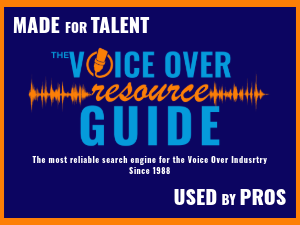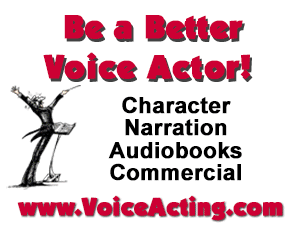|
VOICE ACTING Think You Have A Handle On The Voice Over 'Conversational Read'? Now Add EMPATHY By Anne Ganguzza By Anne GanguzzaVoice Actor, Coach, Demo Producer Fashions follow the times. The same can be said about how the style of voice over reads has changed over the decades. Back in the 1950s when voice recording was new, the announcer style was born out of necessity. Recording technology dictated a need for louder, more forceful voices to help the recordings be as clear as possible. That style of read stuck around for quite some time. But technology evolved and styles changed. LET'S CHAT ... As technology got better, voice talent no longer had to shout to be heard. The stilted forceful read started to become associated as fake, disingenuous, and pushy. Welcome to the conversational read. As consumers increasingly became savvier with product and competitor information at their fingertips, the conversational style became the preferred read as it increased sales. Consumers didn't want to be "told" what they should do. They wanted to make their own decisions. A trusted friend would be much more persuasive than a salesman. The conversational read has been king for many years, but we are starting to see a dawn of an evolving conversational read with even more layers. One that focuses on empathy. Let's take a quick look at the conversational read foundations, and what's changed. ADDING EMPATHY: FIRST, LISTEN Foundationally, the empathetic read has it's roots firmly planted in its predecessor. Being able to execute an honest and genuine conversational script interpretation is still core, but now there is an added twist. Think of it as a change in spice on your favorite dish. Above all, you have to be able to hear the melody of the conversational read. For instance, chatting with a friend sounds completely different from giving a presentation to a group of coworkers. As a voice actor, you have to be able to recognize these differences quickly. My number one piece of advice to help you hear and remember the differences in melody is to actually record yourself having a conversation. Over the phone, in person, on Zoom, whatever the method, find a way to capture at least your side of the conversation. Then listen. Really listen. This will allow you to develop an ear for the melody of conversational speak, which will help you know when you are conversational - and more importantly, when you are not! Listen for three key elements:
Once you can hear those elements, you can start to incorporate your empathy layer. PITCH PERFECT One key giveaway of an announcer or the "read-y" style read is a false-sounding higher pitch. A lot of times when we are performing or simply cold reading, we tend to sound the words out as we read from left to right in a higher than normal "note," not thinking about the scene or conversation that we need to be having for authenticity. For many of us of a certain "age" :) we have spent years listening to announcery styles of advertising. This melody plays over and over in our heads and tries to take over our VO Life (especially when the copy is not written in a conversational manner). If you listen back to your recorded conversations from earlier, you'll probably notice a lower pitch in your voice than in your recorded auditions or reads. If you don't hear it, listen again. Typically in a conversation, we're relaxed, which translates into the vocal cords as well. Relaxed vocal cords lead to a lower-pitched tone. If coaches or peers are telling you that you sound too "read-y," more than likely it's your tone. Consider starting your voice over a half to whole pitch lower. This conscious effort will help you to relax and remember to lower your pitch throughout the script. It can also help to lead in with a conversational starter. PROPER PHRASING One of the key elements of any authentic conversational read is phrasing. During the course of a normal conversation, our goal is to express concepts or ideas in such a way that who we are talking to understands the idea we're trying to communicate. We aren't concerned with sounding pretty, or professional. This same concept is true in the conversational read. Anything disconnected or words that are too separate from one another start to lose their flow and can sound like you're "reading." When you look at your script, find the concepts or ideas and move through them without taking a breath or breaking the words apart. Think of each idea like books on a shelf. There are bookends at each side. If you take a book out of the middle of the shelf, the books lose stability and will topple over. If you take a bookend away, the books won't stay up either. You have to keep the meaning or idea of the phrase all in one piece, otherwise it all falls apart. Start by getting in the habit of marking up the scripts to help you define these bookends until you get used to quickly dissecting the content for concepts and ideas. AND PACE YOURSELF Once you understand how to phrase your ideas, the next thing you'll notice is the pacing within each phrase. In a conversation we tend to slightly draw out or elongate the important words in a sentence. Conversely, we tend to speed up fluffy or "filler" words. Instead of turning up the volume, or infecting your pitch to be unnaturally high for those important words, think about giving them a little more "length" within the idea. If you understand how to read music, emphasized words would be the whole notes. The rest of your conversation would be the quarter, eighth and sixteenth notes. If for some reason you had to use a telegraph to send a message where you pay by the word, you would do your best to only use the important words to communicate your message. Like, "Stop Mail Gone Vacation." You get the meaning straight away. The longer version could be something like, "I would appreciate if you could stop my mail for a while, I've gone on vacation for a few weeks." The important words are the whole notes, the ones we just slightly stay on for a bit longer. ADD THE SPICE Empathy is an added spice on the top of the conversational read. In these unprecedented times, it's obvious that recent events have shifted the landscape of our everyday interactions. (Need I say more?) But empathy in the conversational read can be found in copy from years ago. This ad from Proctor and Gamble in 2012 is a prime example of how brands started to use empathy in order to connect with their consumers ... Since then, advertisers have fully embraced the empathetic ad, and with them come a new flavor of the conversational read. Empathy should be genuine and understated, never overly sweet or emotional. It's not about being overly compassionate, either - just understanding and empathizing with your listener's pains and joys. Empathy is something that is offered, not forced. It only really works as a part of a relaxed, conversational style. Once you understand the basic concepts of the conversational read, start to sprinkle on a dash of empathy. It takes practice and coaching to master, but is worth the time and effort because empathy - a fundamental for our human to human connection - is here to stay. -------------------- ABOUT ANNE Anne Ganguzza is a full-time voice talent and award-winning director and producer who works with students to develop their voice over and business skills - including VO demo training and production. She specializes in Conversational Commercial and Narration styles, including Corporate, E-Learning, Technology, Healthcare - Medical, Telephony, and On-Hold. Located in Orange County, CA, Anne offers private coaching and mentoring services to students in person and via Skype, ipDTL or Zoom. Email: anne@anneganguzza.com Web: www.AnneGanguzza.com |
Tell Us What YOU Think!
Please Note: Since we check for spam, there will be a slight delay in the actual posting of your comment.
Comments (4)
Dave Clarke
12/19/2020 at 8:31 AM
This is information GOLD! For those of you new to the business of Voice Over, what Anne has written here many of us, including me spent a lot of money and time to learn and understand. Take what she's dropped here and practice it! :)
J. Valentino
12/15/2020 at 5:24 PM
...actually very good article. One of the more helpful articles.
J. Valentino
12/15/2020 at 5:14 PM
While this is helpful, please note, the conversational read is just ONE style. It's not the predominate style, and it's a myth that keeps being spread. Movie trailers are not conversational, TV promos are not conversational, car dealership ads are not conversational, concerts are not conversational, radio imaging is not conversational, call to action informercials are not conversational, I could go on and on. The Announcer style is alive and well and usually where the money is. But thank you for the tips on when a conversational style is called for. But it's not the predominate style in VO. It's just one style of read.
Roger William Steele
12/15/2020 at 1:16 PM
Excellent advice and very well written. Thanks










click for new article alerts